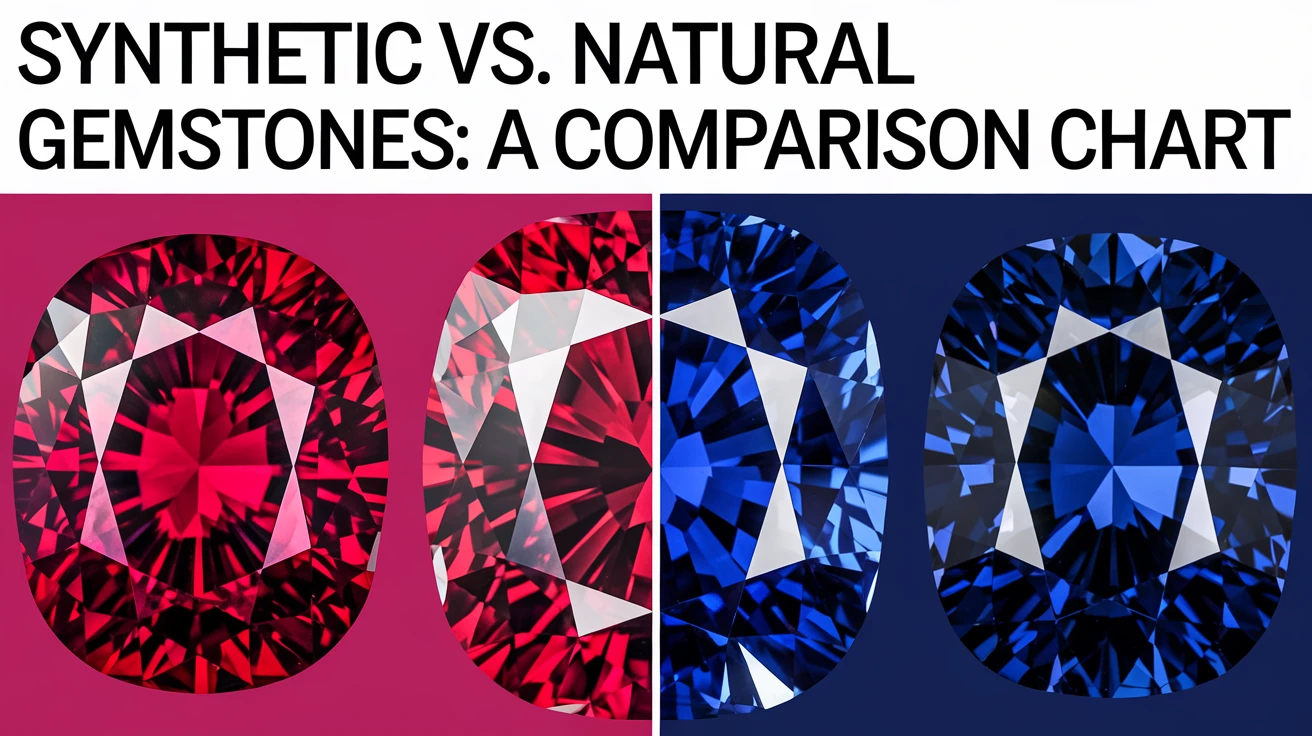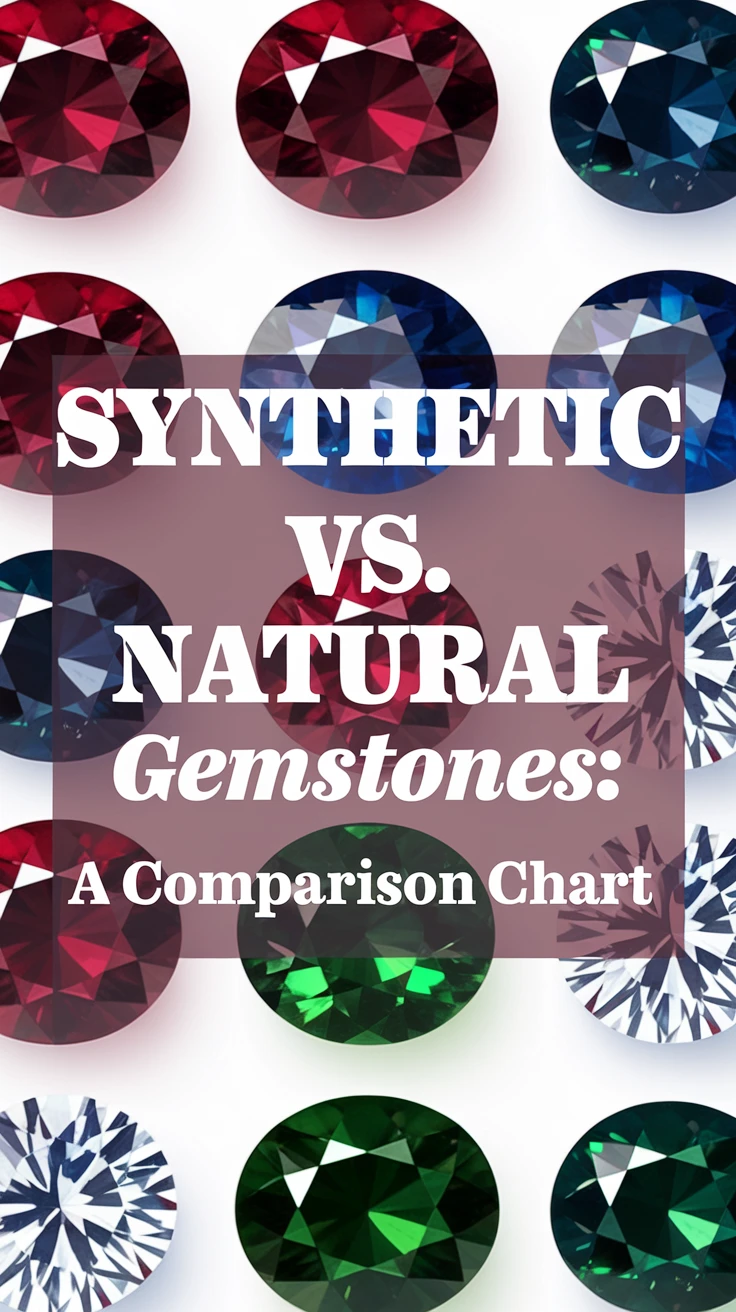
Understanding the World of Synthetic vs. Natural Gemstones
When it comes to choosing the perfect gemstone, one of the most significant decisions buyers face is whether to opt for natural or synthetic stones. This comprehensive synthetic vs. natural gemstone chart and guide will help you understand the key differences, benefits, and considerations of each option. As someone who’s spent years studying and collecting both types, I can tell you that neither choice is inherently better – it all depends on your specific needs and preferences.
The Ultimate Synthetic vs. Natural Gemstone Chart
| Characteristic | Natural Gemstones | Synthetic Gemstones |
|---|---|---|
| Formation | Naturally occurring in Earth | Lab-created under controlled conditions |
| Time to Form | Millions of years | Days to months |
| Chemical Composition | Natural variations | Identical to natural |
| Inclusions | Natural, random patterns | Few to none, or distinctive patterns |
| Color Consistency | Variable | Uniform and predictable |
| Price Range | Higher, varies significantly | Lower, more consistent |
Physical Properties and Characteristics
The physical properties of synthetic and natural gemstones often surprise many buyers. While both types share identical chemical compositions, their physical characteristics can vary significantly.
- Crystal Structure: Both types maintain identical crystal structures
- Optical Properties: Similar refractive indices and dispersion
- Hardness: Identical on the Mohs scale
- Color Saturation: Often more consistent in synthetics
- Inclusions: Different patterns and frequencies
Pro tip: When examining gemstones, use a 10x loupe to look for distinctive inclusion patterns that can help identify synthetic stones.
Value and Pricing Analysis
The price difference between synthetic and natural gemstones can be substantial, often ranging from 30% to 90% less for synthetic stones. Here’s a detailed breakdown:
| Gemstone Type | Natural Price (per carat) | Synthetic Price (per carat) |
|---|---|---|
| Ruby | $500-$15,000+ | $50-$150 |
| Sapphire | $400-$10,000+ | $40-$120 |
| Emerald | $300-$9,000+ | $30-$100 |
Pro tip: Always request certification for natural gemstones to ensure you’re paying an appropriate price for the quality.
Formation Process Differences
Understanding how each type forms helps explain their unique characteristics and value propositions.
Natural Formation
- Occurs over millions of years
- Subject to natural pressure and temperature variations
- Results in unique inclusions and characteristics
- Limited by natural resources
Synthetic Formation
- Controlled laboratory environment
- Consistent conditions
- Predictable results
- Environmentally controlled process
Pro tip: The controlled environment of synthetic formation often results in more consistent color and clarity.
Identification Methods
Distinguishing between synthetic and natural gemstones requires specific tools and knowledge:
- Visual Inspection
- Check for inclusion patterns
- Examine color zoning
- Look for growth patterns
- Advanced Testing
- Spectroscopic analysis
- Microscopic examination
- UV fluorescence testing
Pro tip: Always have important stones verified by a certified gemologist.
Durability and Maintenance
Both synthetic and natural gemstones require proper care to maintain their beauty:
- Cleaning requirements are identical
- Both types maintain same hardness levels
- Similar resistance to chemicals
- Equal susceptibility to physical damage
Pro tip: Store both types separately to prevent scratching, regardless of origin.
Environmental and Ethical Considerations
The environmental impact of gemstone sourcing has become increasingly important:
- Natural mining can cause environmental damage
- Synthetic production has a smaller environmental footprint
- Labor conditions in natural mining can be concerning
- Lab creation provides controlled working conditions
Pro tip: If environmental impact is a primary concern, synthetic stones offer a more controlled and often more sustainable option.
Market Value and Investment Potential
Understanding the long-term value implications is crucial:
- Natural stones typically appreciate over time
- Synthetic stones maintain stable, lower values
- Rarity affects investment potential
- Market demand influences price trends
Pro tip: Consider natural stones for investment purposes and synthetic ones for fashion jewelry.
Key Takeaways
- Both types have identical chemical compositions
- Natural stones command higher prices due to rarity
- Synthetic stones offer consistency and affordability
- Environmental impact differs significantly
- Investment potential varies between types
Conclusion
The synthetic vs. natural gemstone chart comparison reveals that both options have their place in the market. Natural stones offer uniqueness and potential investment value, while synthetic stones provide affordability and consistency. Your choice should align with your personal values, budget, and intended use. Remember that both types are “real” gemstones – they simply differ in their origin stories.
Frequently Asked Questions
How can I tell if a gemstone is synthetic or natural?
Professional gemological testing is the most reliable method. Visual clues include inclusion patterns, color consistency, and growth patterns, but these require expertise to interpret accurately.
Are synthetic gemstones fake?
No, synthetic gemstones are chemically identical to their natural counterparts. They’re real gems, just created in a laboratory rather than formed in nature.
Do synthetic gemstones have the same value as natural ones?
Synthetic gemstones typically cost 30-90% less than natural ones and don’t appreciate in value the same way natural stones do.
Which gemstones are most commonly synthesized?
Ruby, sapphire, emerald, and diamond are the most commonly synthesized gemstones due to high demand and significant price differences from their natural counterparts.
Are synthetic gemstones more durable than natural ones?
They have identical durability as they share the same chemical composition and crystal structure.

